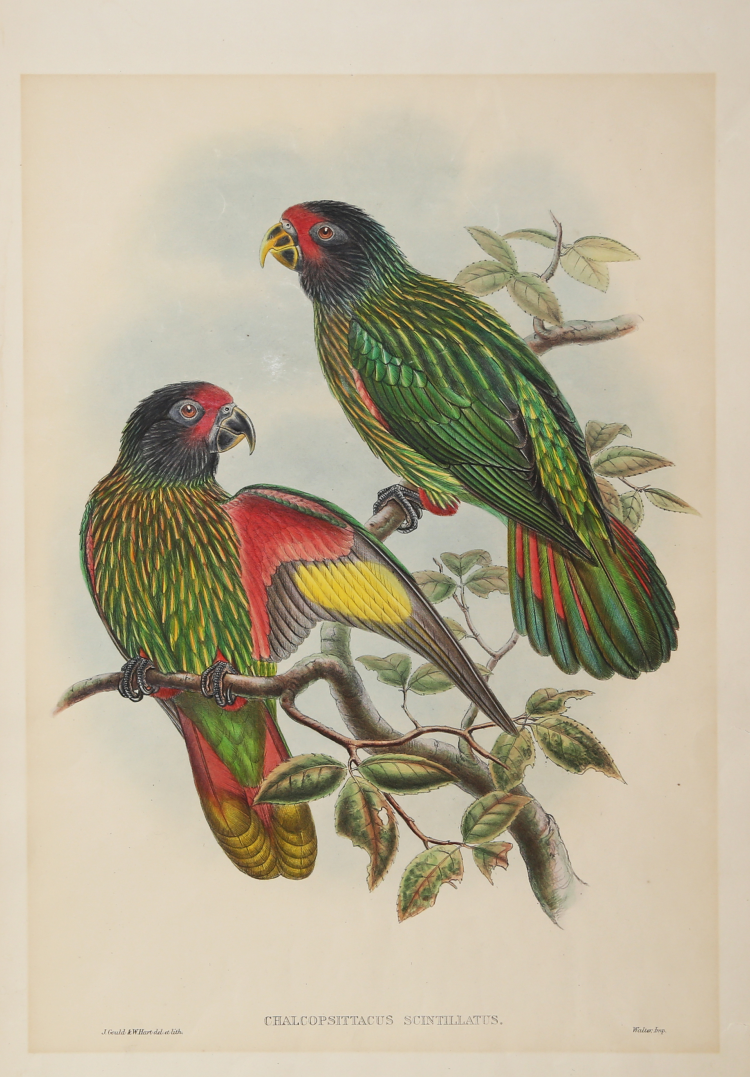



| Reference: | s26969 |
| Author | John GOULD |
| Year: | 1875 ca. |
| Printed: | London |
| Measures: | 390 x 560 mm |


| Reference: | s26969 |
| Author | John GOULD |
| Year: | 1875 ca. |
| Printed: | London |
| Measures: | 390 x 560 mm |
Litograph taken form the famous The Birds of New Guinea and the Adjacent Papuan Islands, Gould’s last great work.
With only about 250 sets made, it is amongst the rarest of all Gould's works and was completed after his death by Richard Bowdler Sharpe.
Sharpe then in charge of the of the bird collection at the British Museum, assumed the authorship halfway through the series in 1881, after the twelfth part had been issued. Sharpe was more than forty years junior to Gould, whom he had meet when he was only fifteen, and they both shared a passionate interest in ornithology. In his last years, although an invalid and often in pain, Gould was always pleased when Sharpe visited him to look at his collection of skins and discuss the latest bird discoveries.
John Gould (Lyme Regis, 14 September 1804 - London, 3 February 1881) was a British ornithologist and naturalist. Destined from his youth to follow his father's career as a gardener at Windsor Castle, thanks to his early knowledge in taxidermy had the opportunity to enter at only 23 years (1827) in the Museum of the Zoological Society of London, as a conservator. Gould refined his artistic and scientific knowledge in ornithology, consulting the best works of the time, in particular those of John James Audubon, William Swainson and Thomas Bewick. Between 1832 and 1837 appeared The Birds of Europe, a work in 5 volumes and with 448 plates lithographed and colored by hand. For this gigantic undertaking Gould availed himself of the collaboration of his wife and the famous English poet and painter Edward Lear. A prerogative that saved Gould from economic collapse from the very beginning was that of dealing with these expensive works by publishing them in subscriptions and in dossiers.
After a trip to Australia and Tasmania, he published, with the help of Elizabeth for the first volumes, The Birds of Australia (1840-1848) in 7 volumes and 600 plates, followed between 1851 and 1869 by a Supplement of 81 plates. Between 1862 and 1873 he published The Birds of Great Britain, in 5 volumes and 367 plates. He published 41 books, for a total of 2999 plates lithographed and hand-painted, almost all dedicated to birds, thus establishing himself among the most famous English ornithologists of the Victorian age.
Perfect condition.
John GOULD (Lyme Regis 1804 – Londra 1881)
|
English ornithologist and bird artist. Gould's position brought him into contact with the country's leading naturalists, and also meant that he was often the first to see new collections of birds given to the Zoological Society of London. In 1830 a collection of birds arrived from the Himalayas, many not previously described. Gould published these birds in A Century of Birds from the Himalaya Mountains (1830–1832). The text was by Nicholas Aylward Vigors and the illustrations were lithographed by Gould's wife Elizabeth, daughter of Nicholas Coxen of Kent. Most of Gould's work were rough sketches on paper from which other artists created the lithographic plates. This work was followed by four more in the next seven years including Birds of Europe in five volumes – completed in 1837, with the text written by Gould himself, edited by his clerk Edwin Prince. Some of the illustrations were made by Edward Lear as part of his Illustrations of the Family of Psittacidae in 1832. Lear however was in financial difficulty and he sold the entire set of lithographs to Gould. The books were published in a very large size, imperial folio, with magnificent coloured plates. Eventually 41 of these volumes were published with about 3000 plates. In 1838 he and his wife moved to Australia to work on the Birds of Australia and shortly after his return to England, his wife died in 1841.
|
John GOULD (Lyme Regis 1804 – Londra 1881)
|
English ornithologist and bird artist. Gould's position brought him into contact with the country's leading naturalists, and also meant that he was often the first to see new collections of birds given to the Zoological Society of London. In 1830 a collection of birds arrived from the Himalayas, many not previously described. Gould published these birds in A Century of Birds from the Himalaya Mountains (1830–1832). The text was by Nicholas Aylward Vigors and the illustrations were lithographed by Gould's wife Elizabeth, daughter of Nicholas Coxen of Kent. Most of Gould's work were rough sketches on paper from which other artists created the lithographic plates. This work was followed by four more in the next seven years including Birds of Europe in five volumes – completed in 1837, with the text written by Gould himself, edited by his clerk Edwin Prince. Some of the illustrations were made by Edward Lear as part of his Illustrations of the Family of Psittacidae in 1832. Lear however was in financial difficulty and he sold the entire set of lithographs to Gould. The books were published in a very large size, imperial folio, with magnificent coloured plates. Eventually 41 of these volumes were published with about 3000 plates. In 1838 he and his wife moved to Australia to work on the Birds of Australia and shortly after his return to England, his wife died in 1841.
|